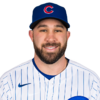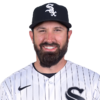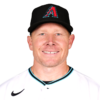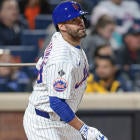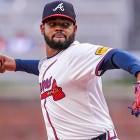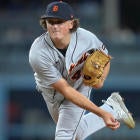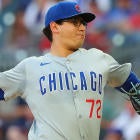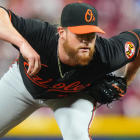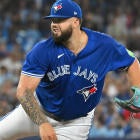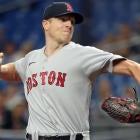One of the really fun things about Fantasy is having success with the players you believed in from Day 1. Yet just as important, but harder to see, are the disasters you avoided on Draft Day.
That's why we do busts lists before every season. And if you were able to avoid investing too much in players like Jose Reyes and Jeff Samardzija last season, you should feel just as good as if you were smart enough to get Lorenzo Cain or Dallas Keuchel at a bargain price.
Successfully picking busts is not all that easy, since it involves more than just identifying players who are due to decline. It requires finding players whose production will drop off yet are not creating the appearance of being candidates for decline. The 12 players featured here all showed some signs of being headed for a dropoff in their performance, yet each could be far more popular than those indicators suggest they should be.
At this point in the Hot Stove season, it's not always easy to tell how most Fantasy owners will value players, so this list -- as well as those for our projected sleepers and breakouts -- will be revised as we get closer to Draft Day. For now, though, these dozen players appear to have the best chance to disappoint their owners in 2016.
With his move from the Braves to the Astros, Evan Gattis looked primed for big things in 2015. He would get more regular playing time and a much better home park for power-hitting. As the Astros' full-time designated hitter, the playing time was there, and Gattis set career highs for home runs, RBI and runs. Given that only Buster Posey had more Fantasy value among catchers, Gattis seemed to come through as owners were hoping.
Gattis' gains in runs were proportionate to his increase in playing time and he drove in runs at a higher rate than in 2014. Then again, Gattis was part of a much better offensive lineup with the Astros than he was with the Braves, and he also slugged 48 points higher with runners on base than he did overall. Given that Gattis showed no signs of being especially clutch before last season, something doesn't quite add up here.
It's hard to get excited about Gattis' run production when his power was clearly something less than what it was during his two years with the Braves. His home run rate dropped substantially, as his ground ball rate rose from 40 to 47 percent and his home run per flyball ratio fell from 15 to 13 percent. The latter stat is no fluke, as his average flyball distance fell by 12 feet (according to BaseballHeatMaps.com) and his pull and hard-hit rates plunged as well (according to FanGraphs).
Factor in the value that Gattis loses by no longer being eligible at catcher (or any position besides DH), and there is no reason to reach for him any earlier than you would Jay Bruce. Actually, since Bruce can draw walks, steal a few bases and is assured of outfield eligibility, he should be taken before Gattis in Rotisserie leagues, somewhere in the middle rounds. There is no need to draft Gattis at all in standard mixed points leagues.
Kendrys Morales had his best season since 2009, overcoming the years of disappointment that followed his gruesome ankle injury in May 2010. Even with 41 doubles, Morales' power (including 22 homers) didn't distinguish him among first base eligible hitters, as he finished outside the top 10 at the position. It was his run production that got him within reach of that status.
Morales fell two RBI short of his career high of 108, which he attained with the Angels in 2009. Yet his skill indicators from last season have more in common with those from his 2013 season with the Mariners, when he drove in 80 runs. Some of the improvement over his 2013 total can be chalked up to hitting in a better lineup, but something else was in play. He was otherworldly at the plate when there were runners in scoring position, and he hit 26 of his doubles when there were runners on base.
There is an argument to be made that Morales is clutch; his career batting average with RISP is .291, as compared to a .265 average with the bases empty. Still, that pales in comparison with the 79-point gap in last season's marks. If that gap closes next season, there are few signs that Morales will repeat as a top 40 hitter overall. He could actually be downright fringy in standard mixed leagues.
As recently as 2013, Jason Kipnis looked like an emerging elite at second base due to a combination of speed and power. His stolen base totals have been in decline, but while he hit only nine home runs last season, Kipnis hung around in the top eight at his position by belting 43 doubles. That total exceeded his previous career high by seven, and Kipnis also bested his top batting average by 19 points.
He didn't make huge strides as a contact hitter and his plate discipline had eroded slightly, so where did all these doubles come from? As Kipnis' flyball distance trend illustrates, he is a fraction of the power hitter he was three seasons ago. Kipnis' doubles binge resulted from him hitting line drives at a 32 percent rate. That was good enough for 12th place among qualifying hitters, placing Kipnis among the line drive-hitting elite for the first time in his career.
If Kipnis can make that improvement hold up next season, he could maintain his place among the second tier of second basemen, but those doubles and a .361 BABIP are all he really has to hang his hat on. Those are two stats that can vary greatly from year to year, and Kipnis' more reliable stats aren't especially promising.
When Francisco Lindor arrived in the majors, many figured he was ready to be an elite defensive shortstop right away, but the bat might take time to develop. All Lindor did at the plate was become the top shortstop in Fantasy value after the All-Star break. That would be true even if you included Manny Machado, who won't be shortstop eligible heading into 2016.
That auspicious debut sets up big expectations for Lindor's sophomore season, but it's worth pointing out that the bulk of his numbers were compiled of the season's final month-and-a-half. In the first 59 games Lindor played, he put up numbers in line with his recent minor league stats -- a .284/.320/.386 slash line with three stolen bases in five attempts. Lindor boosted his overall batting average by 29 points over his final 40 games with help from a .390 BABIP. He also more than doubled his home run output with seven home runs, including two at Yankee Stadium, one at U.S. Cellular Field and four against lefties.
Even with his speed and ability to hit to all fields, Lindor is unlikely to maintain a BABIP that high for a whole season. His late-season power surge is also suspect, as he fattened up his numbers in home run parks and against southpaws, whom he hit well in the minors. If owners are going to draft Lindor based on his 2015 performance, they will be disappointed if he winds up only producing against left-handed pitchers. That very well could happen, though, so if you draft Lindor within the first five rounds in a mixed league, you are taking a big risk.
Just about everywhere you look in Mike Moustakas' stat line, you find signs of a breakout happening in 2015. He set career highs in home runs, RBI, runs and batting average and matched his career high in doubles, while striking out less and hitting to the opposite field more. Moustakas appears to have reached a new level -- one that placed him among the top 10 third basemen in Fantasy value.
While Moustakas has steadily become a better contact hitter, the other parts of his breakout look suspect. He set a career high with 22 homers, with 15 of those coming after the All-Star break, yet he averaged a 284 feet on flyballs he hit in the second half, only 2 feet longer than the previous season. You could point to the extreme increase in his flyball rate, from 35 percent in the first half to 49 percent in the second half. That does put Moustakas back in line with his flyball rate from 2012, which was his only other 20-homer season, but it also puts him in line to fall well short of the .297 batting average he established in the first half.
Add it all up, and I expect him to hit between 15 and 20 home runs with a batting average in the .250s. You can wait to draft Brett Lawrie to get those numbers.
In his first full season with the Diamondbacks, David Peralta was mired in a left field timeshare for the first two months. A hamstring injury to platoon-mate Ender Inciarte led to everyday at-bats, and when Inciarte returned, it was Yasmany Tomas -- and not Peralta -- who lost significant playing time. It was Peralta's bat that kept him in the lineup, and when Inciarte rejoined the lineup after the All-Star break, Peralta got even hotter.
In the second half, Peralta put up an incredible .360/.401/.577 slash line. All three numbers were aided by his .436 BABIP. There is no denying that Peralta did the sorts of things that help a batter to get hits on balls in play, such as making hard contact, not hitting many flyballs and spraying the ball to all fields. He just didn't do them to the degree that he could be expected to be one of the majors' top hitters on balls in play, much less a historically great one.
It's not only Peralta's batting average that looks due to dip. He amassed 78 RBI, even though he did not play regularly until mid-June. Peralta hit much better with runners on base than with the bases empty, and it's probably assuming too much to expect that he will be similarly clutch in 2016. Also, Peralta did not exactly conquer left-handed pitching, recording a .25o/.311/.375 slash line over 90 plate appearances. If his batting average, run production and playing time all take a hit this coming season, Peralta will have an extremely difficult time maintaining his status as a top 40 outfielder.
Adam Eaton had an incredible second half in 2015, racking up the eighth-highest total of Fantasy points among outfielders. He did a little bit of everything, batting .335 with eight home runs, 15 doubles, 13 stolen bases and 35 walks. Eaton also struck out at a much higher rate than normal, so points leagues were actually his lesser format. Because Eaton hit so well on balls in play, he was able to maintain a lofty batting average, helping him to a fourth-place finish in Rotisserie value among outfielders in the second half.
With such a strong finish, Eaton is bound to be highly valued on Draft Day. Better yet, the upward swing in Eaton's value actually dates back to last June, when he started to hit for power. There is no doubt that Eaton should be much more highly valued on Draft Day than he was a year ago.
But how much higher? It's doubtful that he will be valued as the top 10 outfielder he was after the All-Star break. It would seem much more reasonable to view him as a member of the top 20, since that's where he finished in the full-season rankings in both formats. That would be a mistake. Eaton's BABIP was so inflated over his final 100 games of the season that it allowed him to hit .287 on the year, even though his strikeout rate surged. He may not break .270 this year, and that will impact his run and stolen base production. If you're drafting Eaton as a top 30 outfielder, you're paying too much.
Dexter Fowler is coming off one of his best seasons to date, as he set career highs in runs (102) and home runs (17) and had his highest stolen base total (20) since his rookie season. Staying healthy was a key to Fowler's success, as he also set a career high in games played with 156.
After seven full seasons in the majors, it's fair to call Fowler's one-and-only season with the Cubs an outlier. Actually, his rate stats, like strikeout rate, walk rate and Isolated Power, were in line with his previous seasons, but his counting stats were super-sized. I simply don't trust Fowler to stay healthy in 2016, and for that reason alone, I expect him to underperform his draft position.
Should Fowler have another 150-plus game season, there is still another reason to be skeptical of him approaching his 2015 value. He hit home runs with a similar frequency to his last two seasons in Colorado, which were his first two seasons with double-digit home runs. That seems unlikely, given that Fowler enjoyed the Coors Field power bump that benefits most Rockies hitters, and that he hit flyballs for less distance on average in 2015 than he had in any of this previous three seasons. He may have been a top 30 outfielder in 2015, but he may need everything to break right just to finish in the top 40 in 2016.
In his third season with the Cardinals, Michael Wacha didn't emerge as an ace, but he ranked among the top 25 starting pitchers and didn't backslide in terms of most of his ratios.
One ratio that stood out in a negative way was his 0.94 HR/9 ratio, which grew to 1.06 when he left pitcher-friendly Busch Stadium. Wacha really struggled to limit the long ball against right-handed hitters, who socked 13 home runs against him in 100 1/3 innings. Righties averaged 289 feet on flyballs hit off Wacha, so he was wasn't especially averse to hard contact against them.
With merely average strikeout (7.6 K/9) and walk (2.9 BB/9) ratios, you may wonder how Wacha became a 17-game winner. He may have caught a break on balls in play with a .276 BABIP and he received 5.0 runs of support per nine innings, even though the Cardinals ranked 24th in the majors in runs scored. Maybe Wacha can take the step forward that he missed in 2015, but just maybe he will be a pitcher who, with less good fortune, posts an ERA closer to 4.00.
Wacha's former teammate, Shelby Miller, was at the other end of the spectrum in terms of run support, getting 2.1 runs per nine innings from the Braves' punchless offense. Even though Miller lowered his ERA from 3.74 to 3.02, he wound up with a 6-17 record.
In fairness to Miller, he is almost certain to get better run support, now that he is a member of the Diamondbacks. Whatever help he might get with wins, however, he could give back in ERA. Miller had very ordinary strikeout and walk ratios -- slightly worse than Wacha's -- but he was able to prevent runs because he only allowed 13 home runs over 205 1/3 innings. That outstanding ratio was built almost entirely on his work against right-handed batters, who managed only three homers against him all season.
While Miller is probably due for some regression against righties, he could fare well against them again in 2016. He increased his use of a sinker last year, and versus right-handed batters, he compiled a 64 percent ground ball rate (per BrooksBaseball.net). Miller was far less effective against lefties, and his sinker generated just a 42 percent ground ball rate against them. He also was less effective at striking out lefties.
That created a 111-point rift in his slugging percentage splits between righties and lefties, yet it didn't impact his ERA as much as it could have because Miller stranded 79 percent of his baserunners when facing left-handed hitters. Not only is that number likely to shrink, but opposing managers might take better advantage of Miller's splits. He had the platoon advantage in 51 percent of his plate appearances, as compared to the major league average of 46 percent. If opposing managers respond more aggressively to Miller's splits, it could be a tough season ahead.
Marco Estrada was one of the great comeback stories of 2015, as he returned to Fantasy relevance with a 13-8 record and 3.13 ERA for the Blue Jays. Even though he moved from the Brewers to the Blue Jays and the AL East, Estrada pared down his HR/9 ratio from a gaudy 1.73 to 1.19, and that played a role in his success.
Still, 24 home runs over 181 innings is a lot of homers, and Estrada needed some other kind of help, given that he is not the strike-thrower he once was. When Estrada emerged as a Fantasy option four seasons ago, his main appeal was as someone who could lower your staff's WHIP. He missed bats, didn't walk many hitters, and as a flyball pitcher, he was a candidate for a low BABIP rate. In his first season with the Blue Jays, Estrada was not that kind of pitcher, as he struck out 6.5 batters per nine innings and walked 2.7.
Estrada made up for the increased contact and walks with a .218 BABIP. He does get plenty of easy flyball outs; in fact, Estrada led all qualifying starting pitchers with a 15.0 percent popup rate. Even given his flyball tendencies, there is little chance Estrada repeats a sub-.250 BABIP, much less one under .220. The homers will keep coming, but this time probably with more runners on base.
It would not be surprising to see Estrada's ERA climb close to 4.00, and with moderate strikeout and walk rates, he could miss out on the top 75 for starting pitchers after cracking the top 30 a year ago.
Mark Melancon was the top reliever in Fantasy value last season, so of course, he has nowhere to go but down. Owners will still gravitate to the big strikeout pitchers like Wade Davis, Craig Kimbrel and Kenley Jansen, but Melancon could fall much further in value than many would expect.
He owed much of his Fantasy value to the 53 save opportunities he received, though we have to give him credit for blowing only two of them. In 2016, not only could Melancon see fewer save chances, just as a matter of chance, but he could be less successful in converting them. He has succeeded up to this point by getting grounders or getting swings-and-misses on pitches outside of the strike zone. In each of the last two years, Melancon has been getting fewer swings on those pitches, and last year, he allowed contact at a much higher rate. That's why his strikeout rate dipped and his walk rate has been inching upwards.
Without all of the saves, Melancon had a pretty ordinary 2015. He averaged 7.3 strikeouts per nine innings and posted a 2.23 ERA. There is certainly nothing wrong with that, but they are not numbers that would put Melancon in the Davis/Kimbrel/Jansen class of closers on their own. When you factor in the concerns that come with decreasing velocity and a downward K/BB trend, it's conceivable that Melancon won't make the cut for the top 12 relievers at season's end.











